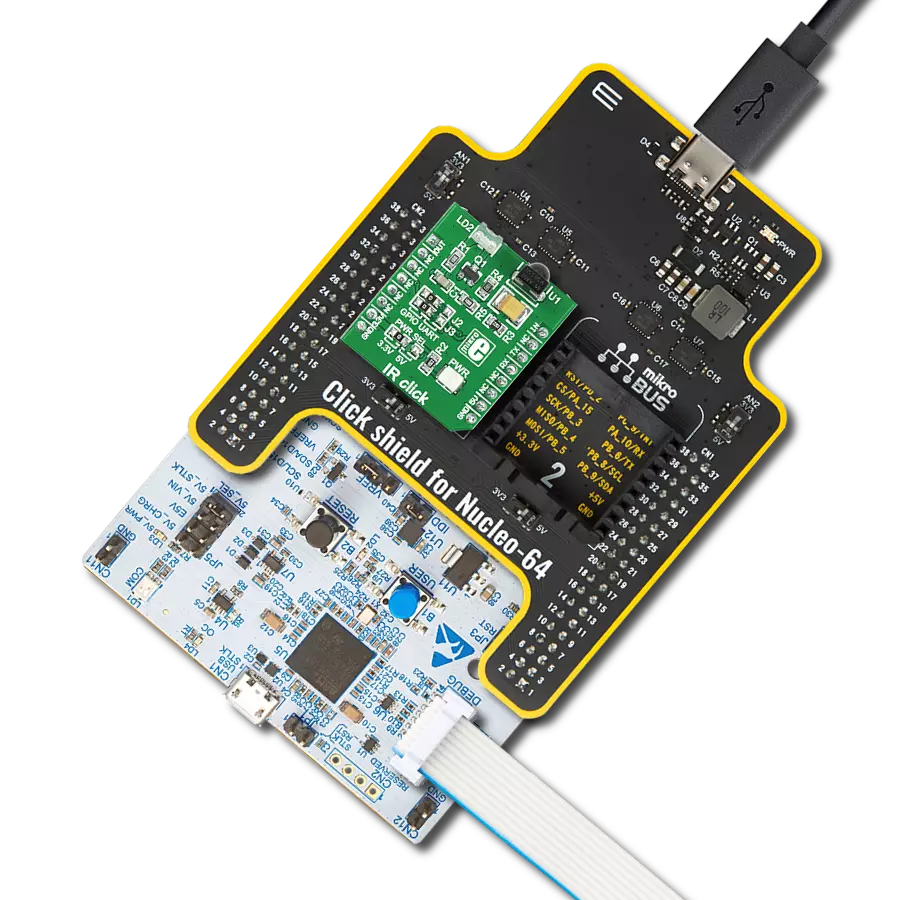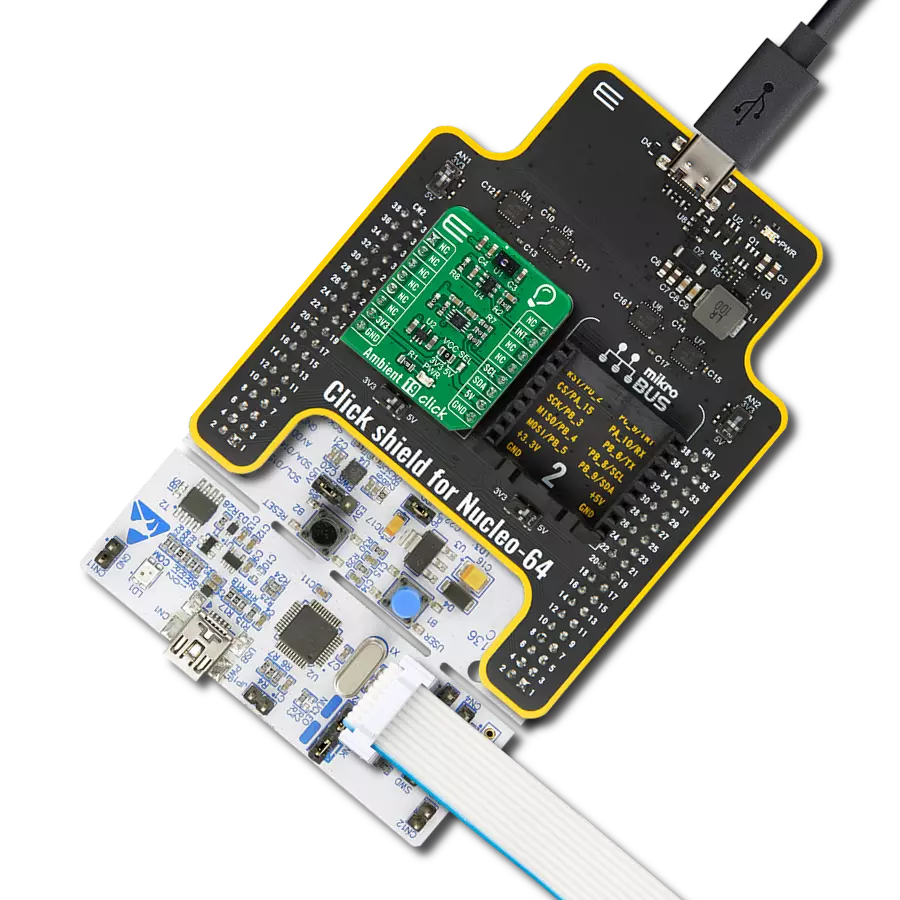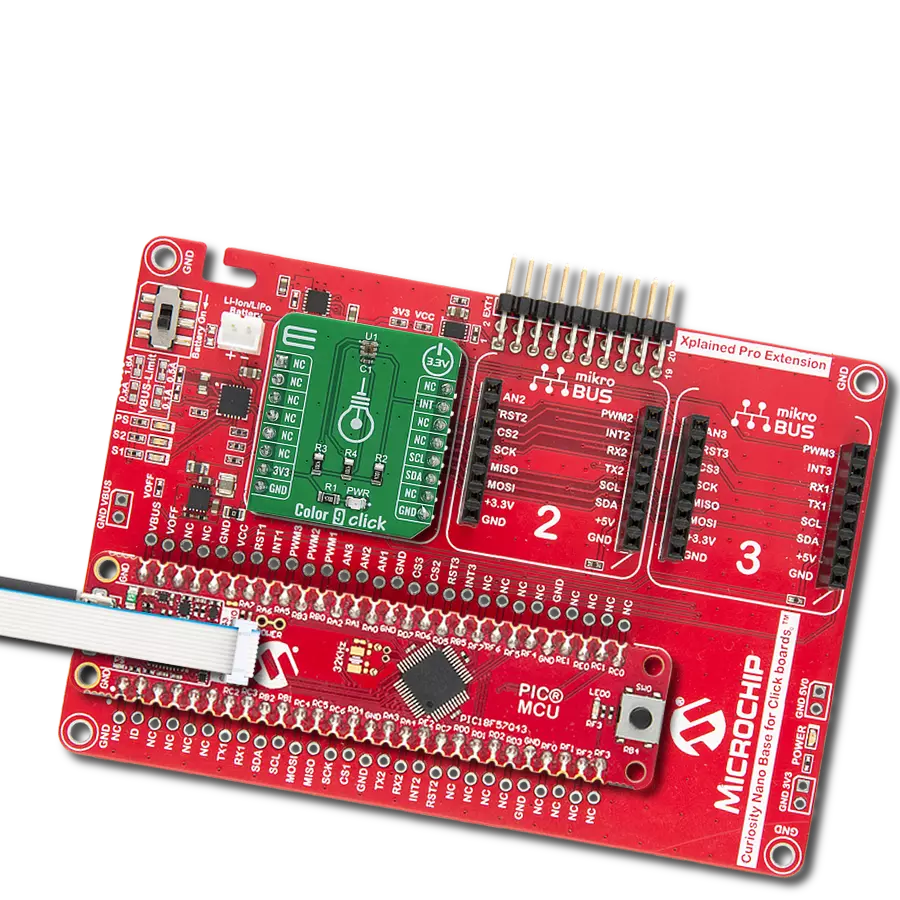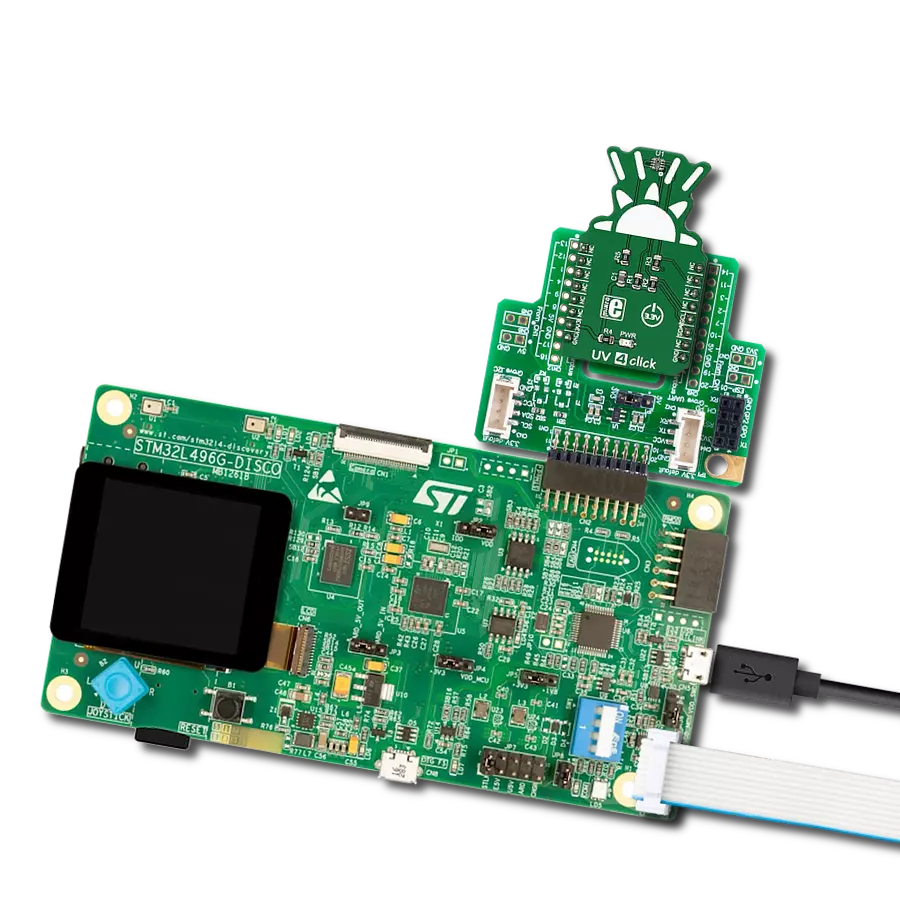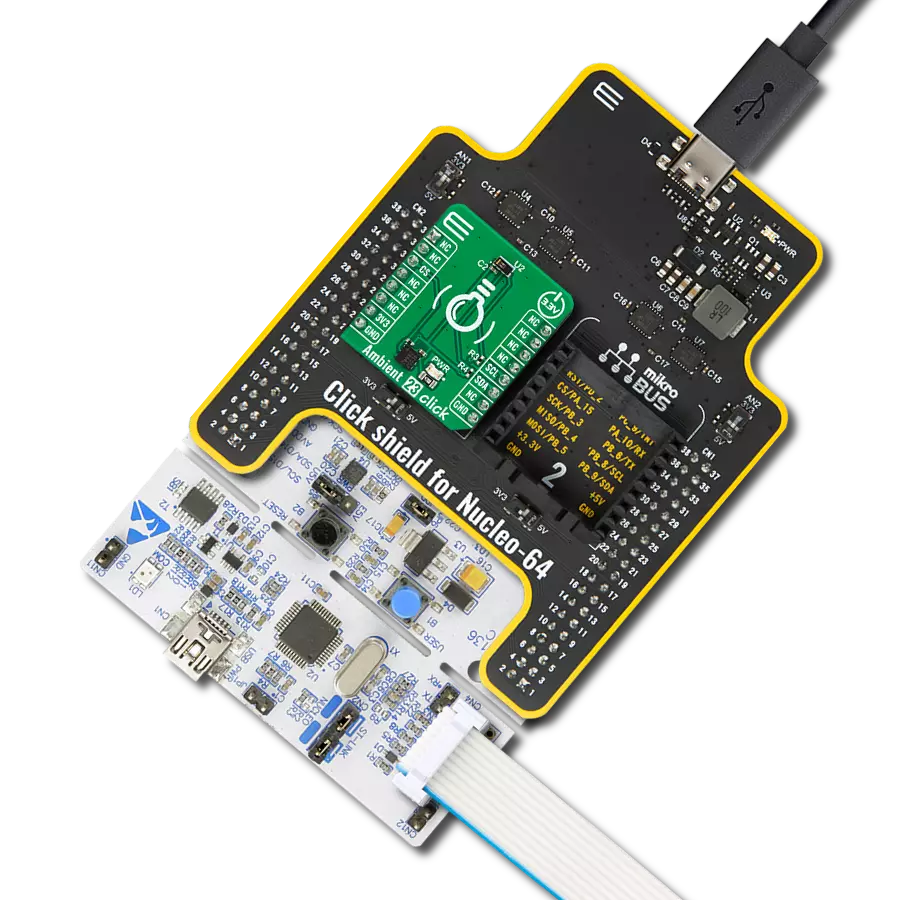An advanced color filtering technology with accurate computation of correlated color temperature and Lux information for your applications
A
A
Hardware Overview
How does it work?
Spectrometer 2 Click is based on the VD6283TX, a color sensor with advanced light flicker extraction from STMicroelectronics. It performs fast and accurate light measurements thanks to an individual ADC with a resolution of 24 bits (16 + 8 bits for high accuracy under low light) and a readout for six color channels: red, green, blue, IR, clear, and visible. Through a serial interface, the color channels can be individually enabled to optimize power consumption alongside 15 programmable gains for a high-dynamic range. Six channels can operate with independent, parallel reading for ALS or flicker operations, one represents a dedicated fast channel for light flicker measurement, and one stands for an internal dark channel. The VD6283TX uses hybrid color filters with precise responses allowing accurate computation of the
correlated color temperature (CCT) and Lux information. Its patented architecture and a high-performance photodiode design can also extract light-flickering frequencies from a minimum of 100Hz and a maximum frequency of 2kHz, including LED square signals, to avoid “banding effects” or check that they are safe for the human eye. Spectrometer 2 Click communicates with MCU using the standard I2C 2-Wire interface with a maximum clock frequency of 1MHz, fully adjustable through software registers. The VD6283TX does not require a specific Power-Up sequence but requires a voltage of 1.8V for its interface and logic part to work correctly. Therefore, a small regulating LDO, the ADP151, provides a 1.8V out of 3.3V mikroBUS™ power rail. Since the sensor for operation requires a power supplyof 1.8V, this Click board™ also
features the PCA9306 voltage-level translator allowing the VD6283TX to work with 3.3V MCU properly. The VD6283TX can stream the following data continuously: ALS color data over the I2C interface and raw flicker data over the AN pin of the mikroBUS™ socket. It also possesses an additional interrupt signal, routed on the INT pin of the mikroBUS™ socket labeled as INT, indicating when a specific interrupt event occurs. This Click board™ can only be operated with a 3.3V logic voltage level. The board must perform appropriate logic voltage level conversion before using MCUs with different logic levels. However, the Click board™ comes equipped with a library containing functions and an example code that can be used as a reference for further development.

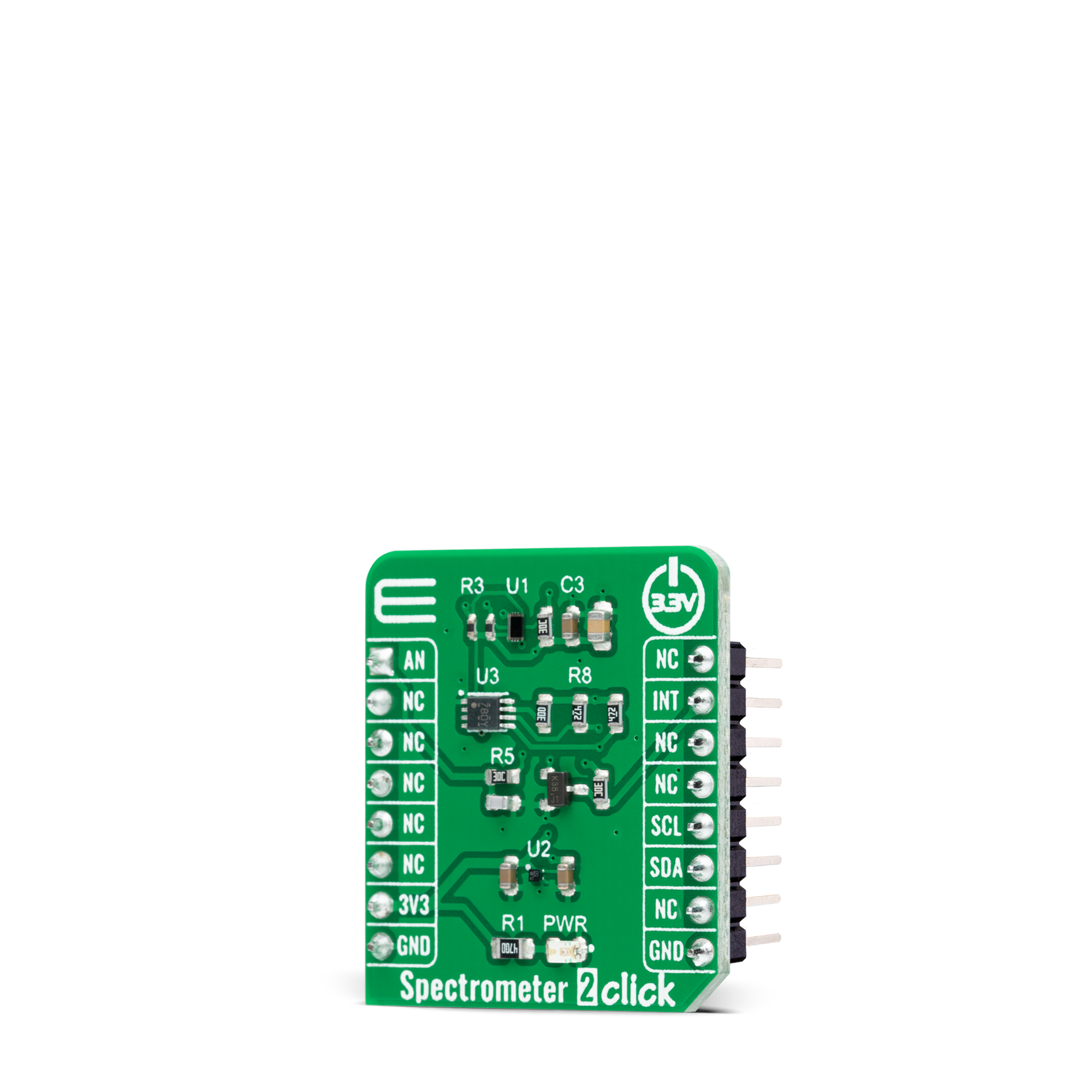
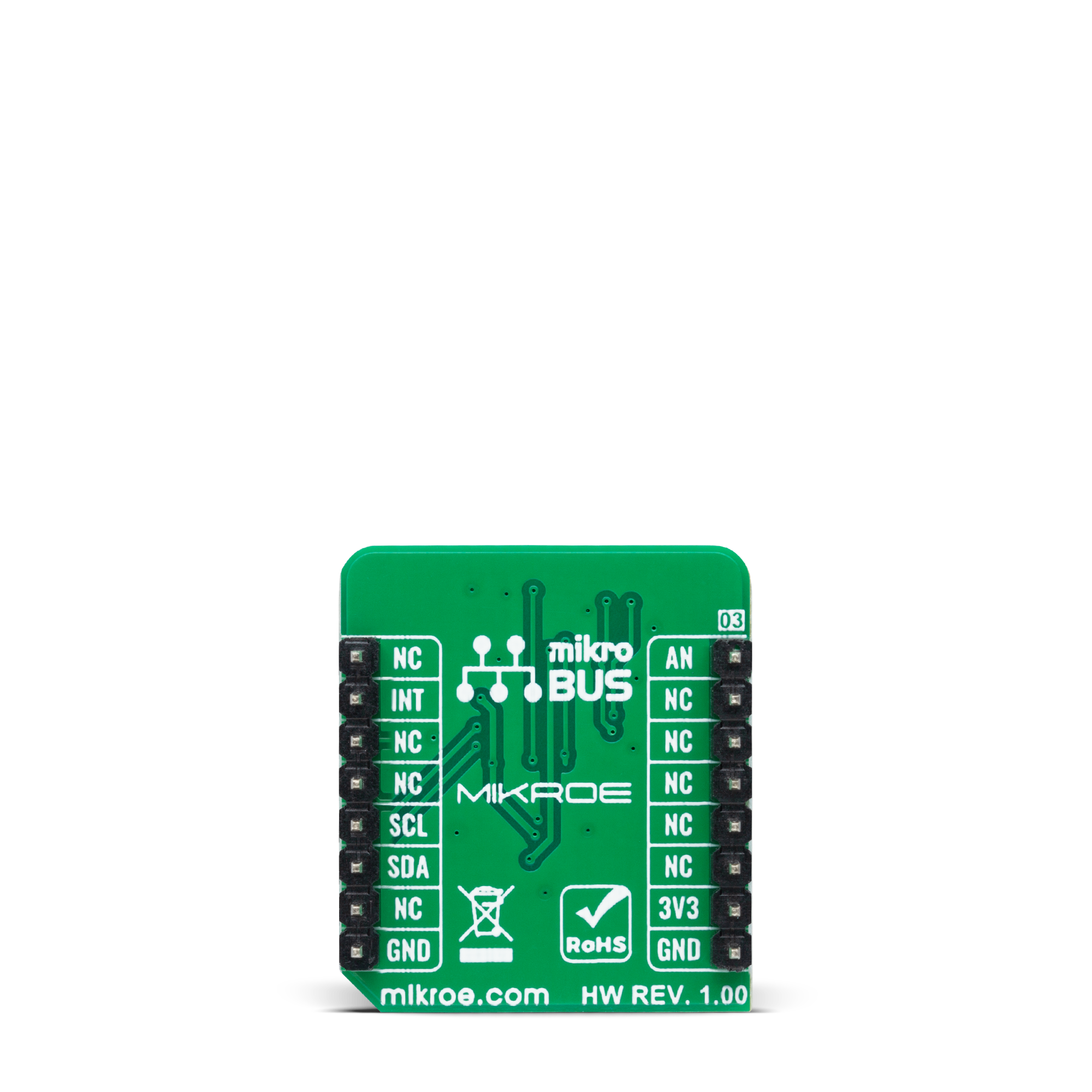
Features overview
Development board
UNI Clicker is a compact development board designed as a complete solution that brings the flexibility of add-on Click boards™ to your favorite microcontroller, making it a perfect starter kit for implementing your ideas. It supports a wide range of microcontrollers, such as different ARM, PIC32, dsPIC, PIC, and AVR from various vendors like Microchip, ST, NXP, and TI (regardless of their number of pins), four mikroBUS™ sockets for Click board™ connectivity, a USB connector, LED indicators, buttons, a debugger/programmer connector, and two 26-pin headers for interfacing with external electronics. Thanks to innovative manufacturing technology, it allows you to build
gadgets with unique functionalities and features quickly. Each part of the UNI Clicker development kit contains the components necessary for the most efficient operation of the same board. In addition to the possibility of choosing the UNI Clicker programming method, using a third-party programmer or CODEGRIP/mikroProg connected to onboard JTAG/SWD header, the UNI Clicker board also includes a clean and regulated power supply module for the development kit. It provides two ways of board-powering; through the USB Type-C (USB-C) connector, where onboard voltage regulators provide the appropriate voltage levels to each component on the board, or using a Li-Po/Li
Ion battery via an onboard battery connector. All communication methods that mikroBUS™ itself supports are on this board (plus USB HOST/DEVICE), including the well-established mikroBUS™ socket, a standardized socket for the MCU card (SiBRAIN standard), and several user-configurable buttons and LED indicators. UNI Clicker is an integral part of the Mikroe ecosystem, allowing you to create a new application in minutes. Natively supported by Mikroe software tools, it covers many aspects of prototyping thanks to a considerable number of different Click boards™ (over a thousand boards), the number of which is growing every day.
Microcontroller Overview
MCU Card / MCU
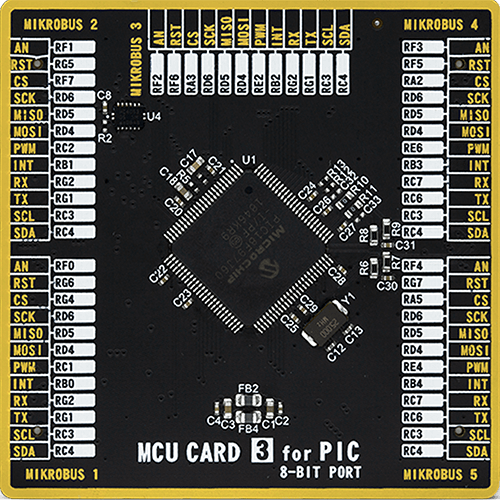
Type
8th Generation
Architecture
PIC
MCU Memory (KB)
128
Silicon Vendor
Microchip
Pin count
100
RAM (Bytes)
3808
Used MCU Pins
mikroBUS™ mapper
Take a closer look
Click board™ Schematic

Step by step
Project assembly
Track your results in real time
Application Output
1. Application Output - In Debug mode, the 'Application Output' window enables real-time data monitoring, offering direct insight into execution results. Ensure proper data display by configuring the environment correctly using the provided tutorial.

2. UART Terminal - Use the UART Terminal to monitor data transmission via a USB to UART converter, allowing direct communication between the Click board™ and your development system. Configure the baud rate and other serial settings according to your project's requirements to ensure proper functionality. For step-by-step setup instructions, refer to the provided tutorial.

3. Plot Output - The Plot feature offers a powerful way to visualize real-time sensor data, enabling trend analysis, debugging, and comparison of multiple data points. To set it up correctly, follow the provided tutorial, which includes a step-by-step example of using the Plot feature to display Click board™ readings. To use the Plot feature in your code, use the function: plot(*insert_graph_name*, variable_name);. This is a general format, and it is up to the user to replace 'insert_graph_name' with the actual graph name and 'variable_name' with the parameter to be displayed.

Software Support
Library Description
This library contains API for Spectrometer 2 Click driver.
Key functions:
spectrometer2_get_dataThis function reads data from 6 ALS channels (Red, Visible, Blue, Green, IR, and Clear).spectrometer2_rgbc_to_hslThis function converts RGBC (red, green, blue, clear) to HSL (hue, saturation, lightness) color value.spectrometer2_get_colorThis function returns the color name flag from the input HSL color.
Open Source
Code example
The complete application code and a ready-to-use project are available through the NECTO Studio Package Manager for direct installation in the NECTO Studio. The application code can also be found on the MIKROE GitHub account.
/*!
* @file main.c
* @brief Spectrometer2 Click example
*
* # Description
* This example demonstrates the use of Spectrometer 2 Click board by reading data
* from 6 ALS channels and converting them to HSL color and displaying those data as
* well as the detected color name on the USB UART.
*
* The demo application is composed of two sections :
*
* ## Application Init
* Initializes the driver and performs the Click default configuration.
*
* ## Application Task
* Waits for the data ready interrupt, then reads the values of all ALS channels and converts
* them to HSL color and displays those data as well as the detected color name on the USB UART
* every 200ms approximately.
*
* @author Stefan Filipovic
*
*/
#include "board.h"
#include "log.h"
#include "spectrometer2.h"
static spectrometer2_t spectrometer2;
static log_t logger;
void application_init ( void )
{
log_cfg_t log_cfg; /**< Logger config object. */
spectrometer2_cfg_t spectrometer2_cfg; /**< Click config object. */
/**
* Logger initialization.
* Default baud rate: 115200
* Default log level: LOG_LEVEL_DEBUG
* @note If USB_UART_RX and USB_UART_TX
* are defined as HAL_PIN_NC, you will
* need to define them manually for log to work.
* See @b LOG_MAP_USB_UART macro definition for detailed explanation.
*/
LOG_MAP_USB_UART( log_cfg );
log_init( &logger, &log_cfg );
log_info( &logger, " Application Init " );
// Click initialization.
spectrometer2_cfg_setup( &spectrometer2_cfg );
SPECTROMETER2_MAP_MIKROBUS( spectrometer2_cfg, MIKROBUS_1 );
if ( I2C_MASTER_ERROR == spectrometer2_init( &spectrometer2, &spectrometer2_cfg ) )
{
log_error( &logger, " Communication init." );
for ( ; ; );
}
if ( SPECTROMETER2_ERROR == spectrometer2_default_cfg ( &spectrometer2 ) )
{
log_error( &logger, " Default configuration." );
for ( ; ; );
}
log_info( &logger, " Application Task " );
}
void application_task ( void )
{
// Wait for the data ready interrupt indication
while ( !spectrometer2_get_int_pin ( &spectrometer2 ) );
spectrometer2_als_channels_t als_channels;
if ( ( SPECTROMETER2_OK == spectrometer2_clear_interrupt ( &spectrometer2 ) ) &&
( SPECTROMETER2_OK == spectrometer2_get_data ( &spectrometer2, &als_channels ) ) )
{
spectrometer2_hsl_t hsl;
spectrometer2_rgbc_to_hsl( &als_channels, &hsl );
log_printf ( &logger, "\r\n Hue: %.1f deg\r\n", hsl.hue );
log_printf ( &logger, " Saturation: %.1f %%\r\n", hsl.saturation );
log_printf ( &logger, " Lightness: %.1f %%\r\n", hsl.lightness );
switch ( spectrometer2_get_color ( &hsl ) )
{
case SPECTROMETER2_RED_COLOR:
{
log_printf( &logger, " Color: RED\r\n" );
break;
}
case SPECTROMETER2_YELLOW_COLOR:
{
log_printf( &logger, " Color: YELLOW\r\n" );
break;
}
case SPECTROMETER2_GREEN_COLOR:
{
log_printf( &logger, " Color: GREEN\r\n" );
break;
}
case SPECTROMETER2_CYAN_COLOR:
{
log_printf( &logger, " Color: CYAN\r\n" );
break;
}
case SPECTROMETER2_BLUE_COLOR:
{
log_printf( &logger, " Color: BLUE\r\n" );
break;
}
case SPECTROMETER2_MAGENTA_COLOR:
{
log_printf( &logger, " Color: MAGENTA\r\n" );
break;
}
case SPECTROMETER2_WHITE_COLOR:
{
log_printf( &logger, " Color: WHITE\r\n" );
break;
}
case SPECTROMETER2_BLACK_COLOR:
{
log_printf( &logger, " Color: BLACK\r\n" );
break;
}
default:
{
log_printf( &logger, " Color: UNKNOWN\r\n" );
break;
}
}
}
}
int main ( void )
{
/* Do not remove this line or clock might not be set correctly. */
#ifdef PREINIT_SUPPORTED
preinit();
#endif
application_init( );
for ( ; ; )
{
application_task( );
}
return 0;
}
// ------------------------------------------------------------------------ END
















